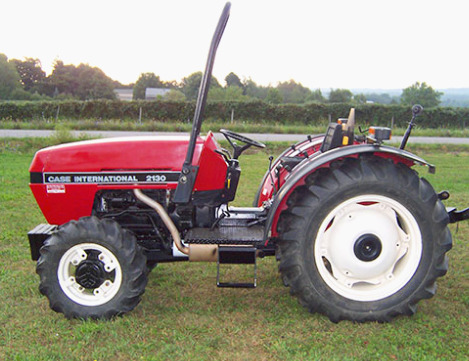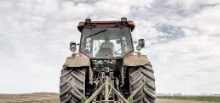________________________________________________________________________________________
| Home / Farm Tractors / Case IH Tractors / Case IH 2130 |
Case IH 2130 Troubleshooting
 The
Case IH 2130 is a 2-wheel drive or 4-wheel drive 2100 series orchard-vineyard
tractor. This model was manufactured from 1988 to 1993. The Case IH 2130 tractor
is powered by SLH 1000.3A 3-cylinder air-cooled diesel engine.
The
Case IH 2130 is a 2-wheel drive or 4-wheel drive 2100 series orchard-vineyard
tractor. This model was manufactured from 1988 to 1993. The Case IH 2130 tractor
is powered by SLH 1000.3A 3-cylinder air-cooled diesel engine.
The 183.1 cubic inches (3 L) engine has a cylinder bore of 4.14" (105 mm), piston stroke of 4.55" (115 mm), and rated power of 52 hp (38.5 kW). The Case IH 2130 is equipped with two transmission options: 8x8 partially synchronized transmission and 12x12 partially synchronized transmission. The maximum travel speed (forward and reverse): 18.1 mph (29.2 km/h).
The open center hydraulic system used a gear pump with rated fluid flow of 15.6 gal/min (59 l/min). The 2WD models are equipped with 5.50-16 or 7.50-16 front tires and 13.6R28 or 14.9R28 rear tires. The 8.25-16 or 7.50-18 front tires and 13.6R28 rear tires are used for 4WD tractors. The wheelbase is 78 in (1980 mm) for 4x2 (2WD) models and 76.6 in (1940 mm) for 4x4 (4WD) models.
| Engine Troubleshooting |
| Engine difficult to start or doesn't start |
Air trapped in fuel system - Bleed air.
Fuel filter element is clogged - Change the filter element.
Defective injection nozzle - Replace injection nozzles.
Dirt or water in fuel system - Drain water or flush dirt from the system.
Valve clearance is wrong - Adjustment procedure required.
Fuel injection pump is faulty - Replace injection pump or repair it.
| Engine starts but then stalls |
Air filter element clogged - Replace air filter element.
Fuel filter element is clogged - Clean or replace the filter.
Problems with fuel injection pump tightness - Inspect fuel injection pump for leaks.
Clogged or defective injectors - Clean fuel injectors or change it.
Fuel injection pump is not operating properly - Replace or repair injection pump.
| Engine stalls after running |
Low coolant temperature - Normalize the temperature by warming up the engine.
Clogged fuel filter - Filter maintenance required.
Air trapped in fuel system - Bleed air.
Faulty fuel injection nozzles - If necessary, replace with a new nozzle.
Timing of fuel injection pump is incorrect - Adjust as recommended.
| Engine stalls at idle |
Incorrectly set low idle speed - Adjust the low idle speed.
Fuel injection pump malfunctioning - Rebuild or replace pump.
Fuel injectors are dirty or defective - Replace fuel injectors.
Excessive valve clearance - Check and adjust as required.
| Engine lacks power |
Plugged air filter - Clean or replace the element.
Fuel injection nozzles are damaged or dirty - Change fuel injection nozzles.
Fuel injection pressure is wrong - Adjust to proper pressure.
Incorrect valve clearance - Correct valve clearance.
Low idle speed adjustment is incorrect - Adjust low idling as recommended.
Fuel hoses or lines are dirty - Clean fuel lines and hoses.
Leaking cylinder head gasket - Change cylinder head gasket.
Defective or worn piston rings - Replace piston rings.
| Engine overheated |
Not enough coolant - Add coolant and check the components of cooling system.
Insufficient engine oil - Need to add engine oil.
Defective radiator cap or clogged radiator core - Install new cap or clean radiator.
Fan belt is worn or faulty - Fan belt must be replaced.
Engine overloaded - Change to lower gear or reduce load.
| Low oil pressure |
Engine oil level low - Fill the crankcase with oil.
Oil filter element clogging - Clean or replace engine oil filter element.
Incorrect oil viscosity - Drain and refill with oil of correct grade and viscosity.
Crankshaft bearing has excessive oil clearance - Bearing replacement required.
Oil pump malfunction - Replace as required.
| Abnormal engine knocking or noise |
Engine oil insufficient - Checking oil level and add if necessary.
Low coolant temperature - Warm up to required temperature.
Improper setting of fuel injection pump timing - Set the fuel pump timing correctly.
Low idle speed setting is not correct - Adjust low idle speed.
Fuel injectors are dirty or defective - Change or clean fuel injectors.
Connecting rod misalignment or failure - Alignment procedure or replacement is required.
Pistons are worn or broken - Replace the pistons.
| Transmission Troubleshooting |
| Transmission oil pressure is insufficient |
Lack of transmission oil supply - Fill up the transmission oil.
Clogged transmission oil filter element (if fitted) - Clean or replace the transmission filter.
Relief valve failure - Replace the valve.
| Transmission noise |
Transmission oil insufficient - Check transmission oil level and add oil as required.
Transmission oil is contaminated - Change the oil.
Worn gears or incorrect backlash - Install new gears and adjust backlash properly.
Worn or damaged bearings - Faulty bearings should be replaced.
Worn or bent shift forks - Change defective shift forks.
Shaft splines are worn or damaged - Replace the shaft.
| Gear shift is hard |
Rusty or worn gear shift linkage - Shift linkage need to be replaced.
Shift forks are worn or bent - Change the shift forks.
Worn parts of the gear shifting mechanism - Change worn parts.
Worn or improperly adjusted clutch - Clutch adjustment or replacement required.
| Transmission oil leaks |
High transmission fluid level - Drain the excess fluid.
Damaged gaskets or seals - Change defective gaskets or seal.
| Hydraulic System Troubleshooting |
| Hydraulic oil pressure is low |
Low hydraulic oil level - Check and refill the hydraulic oil.
Clogged hydraulic oil filter - Clean the hydraulic filter element or replace if necessary.
Faulty hydraulic pump - Install a new hydraulic fluid pump.
Incorrect adjusted hydraulic spool valve - Adjust the spool valve correctly.
Hydraulic cylinder malfunction - Replace or repair hydraulic cylinder.
Leaking hydraulic pipes - Check the system and repair leaks.
| Hydraulic system is overheated |
Main relief valve is faulty - Relief valve need to be replaced.
Wrong hydraulic fluid type - Pour the proper type of fluid.
Hydraulic oil is contaminated - Fill up with fresh hydraulic oil.
Air in the hydraulic system - Air bleeding.
| 3-point hitch fails to lift or lifts slowly |
Excessive load on hitch - Reduce loading.
Hydraulic oil level low - Checking hydraulic oil level and add if necessary.
Clogged hydraulic oil filter - Change hydraulic filter element or clean if necessary.
Damaged hydraulic pump - Replace or repair hydraulic oil pump.
Main relief valve is faulty - Relief valve replacement required.
Hydraulic spool valve block is defective - Repair or replace hydraulic valve.
Hydraulic cylinder failure - Change or repair hydraulic cylinder.
Disconnected or broken suction pipe - Connect or change pipe.
| 3-point hitch won't lower or lowers slowly |
Incorrect setting hydraulic control valve block - Set correctly.
Hydraulic cylinder failure - Replace or repair hydraulic cylinder.
Hitch is out of adjustment - Adjust 3-point hitch as required.
Damaged hitch cross shaft - Change the shaft.
| Hitch lowering or lifting is jerky |
Air in hydraulic system - Bleed air from hydraulic system.
Hydraulic fluid contamination - Change hydraulic fluid.
Hydraulic pump not working - Change or repair hydraulic oil pump.
Hydraulic spool valve block is defective - Repair or change the valve.
Defective hydraulic cylinder - Change or repair hydraulic cylinder.
| Steering System Troubleshooting |
| Steering wheel turns hard |
Incorrectly assembled or damaged steering column - Reassemble the steering column correctly or change it.
Air lock in the steering system - Bleed air from system.
Improper toe-in - Adjust toe-in properly.
Tire pressure uneven - Inflate the tires correctly.
Damaged hydraulic steering pump - Replace or repair steering pump.
Pump flow control valve is damaged or stuck - Change or flush control valve.
Steering fluid level is low - Check fluid level and add steering fluid as required.
| Excessive steering wheel play |
Steering column coupling or shaft is extremely worn out - Change defective part.
Damaged hydraulic steering pump - Repair or change steering pump.
Steering linkage assembly is worn or loose - Inspect and replace as required.
| Tractor pulls to left or right |
Front tyres wear unevenly - Change the tyres.
Incorrect toe-in - Check toe-in and correct.
Steering linkage assembly is worn or loose - Repair or change steering linkage.
Front wheel bearings are defective or improperly adjusted - Change or adjust the bearings properly.
| Electrical System Troubleshooting |
| Battery does not charge |
Electrical cable connections are loose or corroded - Clean or tighten connections.
Faulty electrical terminal connectors - Terminal connectors should be replaced.
Battery dead cell - Replace the battery.
Loose or damaged belt - Adjust belt tension or replace belt.
| Starter cranks slowly |
Low battery power - Battery needs to be recharged.
Battery does not hold charge - Battery needs to be serviced or replaced.
Faulty battery terminals or disconnected cables - Connect wiring correctly or install new terminals.
| Starter will not crank |
Battery is drained or worn - Change or recharge battery.
Disconnected or incorrectly connected wires - Inspect battery wires and connect correctly.
Low battery power - Low battery charging, charge as required.
Starter motor failure - Repair or install a new starter.
________________________________________________________________________________________
________________________________________________________________________________________
| Farm Tractors Technical Specifications |
